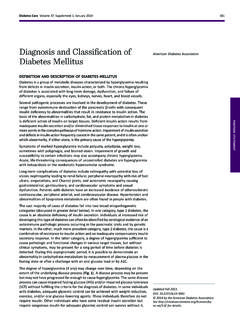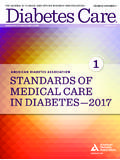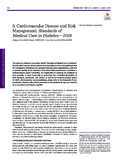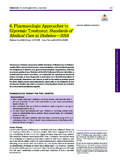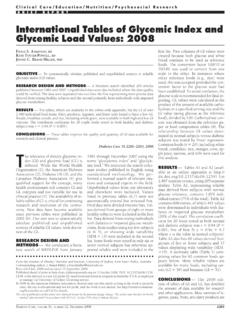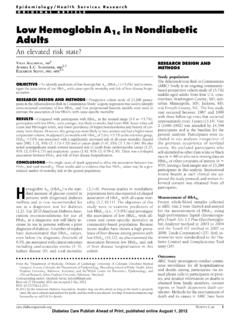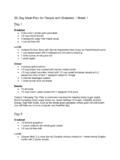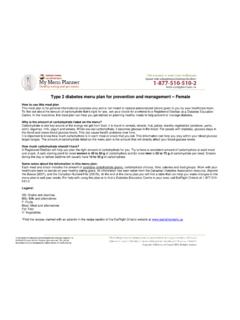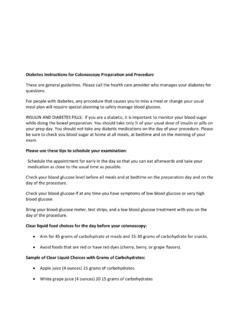Transcription of 1 Nutrition Therapy Recommendations for the …
1 Nutrition TherapyRecommendations for theManagement of Adults WithDiabetesA healthful eating pattern, regular physical activity, and often pharmacotherapyare key components of diabetes management . For many individuals withdiabetes, the most challenging part of the treatment plan is determining what toeat. It is the position of the American diabetes Association (ADA) that there isnot a one-size-fits-all eating pattern for individuals with diabetes . The ADA alsorecognizes the integral role of nutritiontherapy in overall diabetes managementand has historically recommended that eachpersonwithdiabetesbeactivelyengaged in self- management , education,and treatment planning with his or herhealth care provider, which includes the collaborative development of anindividualized eating plan (1,2).
2 Therefore, it is important that all members of thehealth care team be knowledgeable aboutdiabetes Nutrition Therapy and supportits position statement on Nutrition Therapy for individuals living with diabetesreplaces previous position statements,the last of which was published in 2008(3). Unless otherwise noted, research reviewed was limited to those studiesconducted in adults diagnosed with type 1 or type 2 diabetes . Nutritiontherapy for the prevention of type 2 diabetes and for the management ofdiabetes complications and gestational diabetes mellitus is not addressed in grading system, developed by the ADA and modeled after existing methods, wasutilized to clarify and codify the evidence that forms the basis for therecommendations (1) (Table 1).
3 The level of evidence that supports eachrecommendation is listed after the recommendation using the lettersA,B,C, table linking Recommendations toevidence can be reviewed at of the Nutrition RecommendationsWriting Group Committee disclosed all potentialfinancial conflicts of interest withindustry. These disclosures were discussed at the onset of the position statementdevelopment process. Members of this committee, their employers, and theirdisclosed conflicts of interest are listed in theACKNOWLEDGMENTS. The ADA usesgeneral revenues to fund development of its position statements and does not relyon industry support for these OF Nutrition Therapy THAT APPLY TO ADULTS with diabetes To promote and support healthful eating patterns, emphasizing a variety ofnutrient dense foods in appropriate portion sizes, in order to improve overallhealth and specifically to:cAttain individualized glycemic, blood pressure, and lipid goals.
4 Generalrecommended goals from the ADA for these markers are as follows:*cA1C,7%.cBlood pressure,140/80 cholesterol,100 mg/dL; triglycerides,150 mg/dL; HDL for men; HDL mg/dL for and maintain body weight or prevent complications of of Washington Medical Center,Seattle, WA2 Minneapolis Heart Institute Foundation,Minneapolis, MN3 Department of Endocrinology, ABQ HealthPartners, Albuquerque, NM4 American diabetes Association, Alexandria, VA5 Nutrition Concepts by Franz, Minneapolis, MN6 Gillings School of Global Public Health andSchool of Medicine, University of North Carolinaat Chapel Hill, Chapel Hill, NC7 Department of Pharmacotherapy, WashingtonState University, Spokane, WA8 University of Michigan Medical School and theCenter for Preventive Medicine, Ann Arbor, MI9pbu consulting, llc.
5 , Cloquet, MN10 Duke University School of Medicine, Durhum, NCCorresponding authors: Alison B. Evert, and Jackie L. 2014 by the American diabetes for B. Evert, MS, RD, CDE;1 Jackie L. Boucher, MS, RD, LD, CDE;2 Marjorie Cypress, PhD, C-ANP, CDE;3 Stephanie A. Dunbar, MPH, RD;4 Marion J. Franz, MS, RD, CDE;5 Elizabeth J. Mayer-Davis, PhD, RD;6 Joshua J. Neumiller, PharmD, CDE, CGP,FASCP;7 Robin Nwankwo, MPH, RD, CDE;8 Cassandra L. Verdi, MPH, RD;4 Patti Urbanski, MEd, RD, LD, CDE;9andWilliam S. Yancy Jr., MD, MHSC10S120 diabetes CareVolume 37, Supplement 1, January 2014 POSITION STATEMENTT able 1 Nutrition Therapy recommendationsTopicRecommendationEviden ce ratingEffectiveness of Nutrition therapyNutrition Therapy is recommended for all people with type 1 and type 2 diabetes as aneffective component of the overall treatment who have diabetes should receive individualized MNT as needed to achievetreatment goals, preferably provided by an RD familiar with the components ofdiabetes individuals with type 1 diabetes .
6 Participation in an intensiveflexible insulintherapy education program using the carbohydrate counting meal planningapproach can result in improved glycemic individuals usingfixed daily insulin doses, consistent carbohydrate intakewith respect to time and amount can result in improved glycemic control andreduce risk for simple diabetes meal planning approach such as portion control or healthfulfood choices may be better suited to individuals with type 2 diabetes identifiedwith health and numeracy literacy concerns. This may also be an effective mealplanning strategy for older with diabetes should receive DSME according to national standards anddiabetes self- management support when their diabetes is diagnosed and as diabetes Nutrition Therapy can result in cost savingsBand improvedoutcomes such as reduction in A1CA, Nutrition Therapy should be adequatelyreimbursed by insurance and other ,A,EEnergy balanceFor overweight or obese adults with type 2 diabetes , reducing energy intake whilemaintaining a healthful eating pattern is recommended to promote weight weight loss may provide clinical benefits (improved glycemia, blood pressure,and/or lipids)
7 In some individuals with diabetes , especially those early in the diseaseprocess. To achieve modest weight loss, intensive lifestyle interventions (counselingabout Nutrition Therapy , physical activity, and behavior change) with ongoingsupport are mix of macronutrientsEvidence suggests that there is not an ideal percentage of calories from carbohydrate,protein, and fat for all people with diabetesB; therefore, macronutrient distributionshould be based on individualized assessment of current eating patterns,preferences, and metabolic ,EEating patternsA variety of eating patterns (combinations of different foods or food groups) areacceptable for the management of diabetes .
8 Personal preferences ( , tradition,culture, religion, health beliefs and goals, economics) and metabolic goals should beconsidered when recommending one eating pattern over is inconclusive for an ideal amount of carbohydrate intake for people withdiabetes. Therefore, collaborative goals should be developed with the individualwith amount of carbohydrates and available insulin may be the most important factorinfluencing glycemic response after eating and should be considered whendeveloping the eating carbohydrate intake, whether by carbohydrate counting or experience-based estimation remains a key strategy in achieving glycemic good health, carbohydrate intake from vegetables, fruits, whole grains, legumes,and dairy products should be advised over intake from other carbohydrate sources,especially those that contain added fats, sugars.
9 Or index and glycemic loadSubstituting low-glycemic load foods for higher-glycemic load foods may modestlyimprove glycemic and whole grainsPeople with diabetes should consume at least the amount offiber and whole grainsrecommended for the general of sucrose for starchWhile substituting sucrose-containing foods for isocaloric amounts of othercarbohydrates may have similar blood glucose effects, consumption should beminimized to avoid displacing nutrient-dense food consumed as free fructose ( , naturally occurring in foods such as fruit)may result in better glycemic control compared with isocaloric intake of sucrose orstarchB, and free fructose is not likely to have detrimental effects on triglycerides aslong as intake is not excessive (.)
10 12% energy).CB,CPeople with diabetes should limit or avoid intake of SSBs (from any caloric sweetenerincluding high fructose corn syrup and sucrose) to reduce risk for weight gain andworsening of cardiometabolic risk on p. Statement S121 Table 1 ContinuedTopicRecommendationEvidence ratingNNSs and hypocaloric sweetenersUse of NNSs has the potential to reduce overall calorie and carbohydrate intake ifsubstituted for caloric sweeteners without compensation by intake of additionalcalories from other food people with diabetes and no evidence of diabetic kidney disease, evidence isinconclusive to recommend an ideal amount of protein intake for optimizingglycemic control or improving one or more CVD risk measures.


